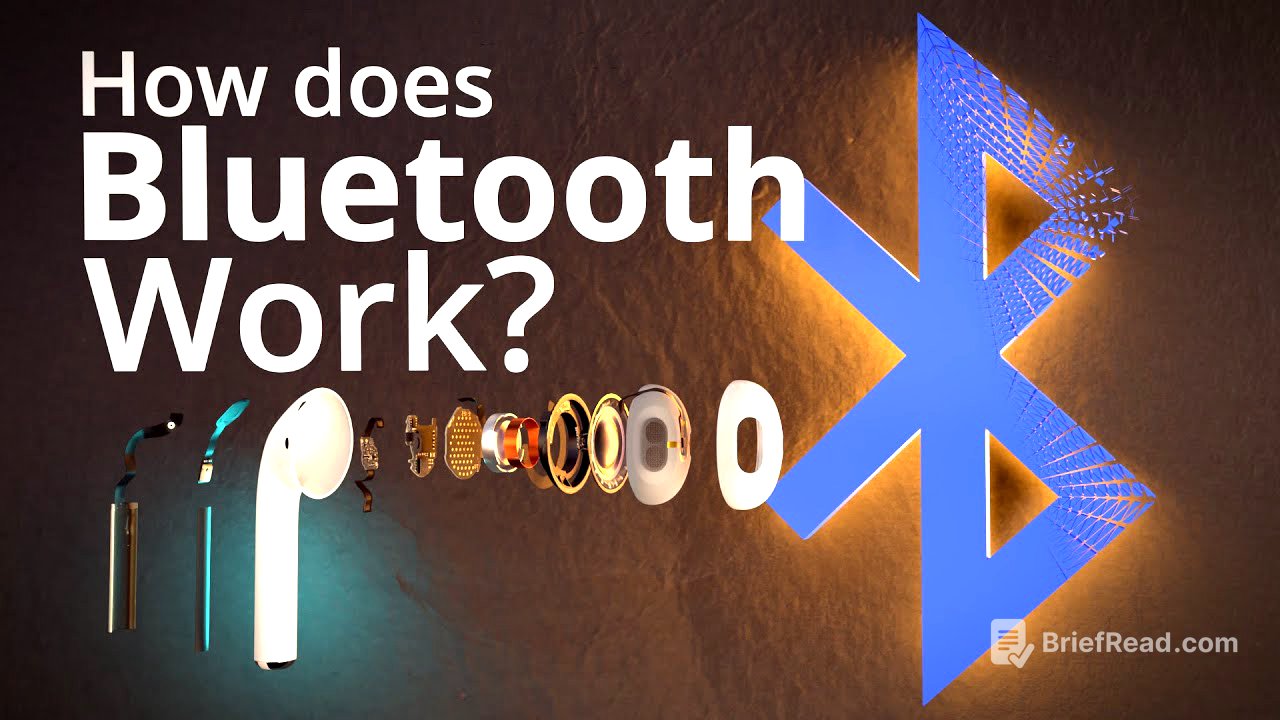TLDR;
This video explains how Bluetooth technology works, using analogies to traffic lights to illustrate the principles of wireless communication. It covers the use of electromagnetic waves, frequency hopping, packet assembly, and error detection to ensure reliable data transmission between devices. The video also touches on the challenges of noise and interference in the 2.4GHz spectrum and the methods Bluetooth uses to overcome them.
- Bluetooth uses electromagnetic waves to transmit data.
- Frequency hopping and packet assembly ensure reliable communication.
- Error detection and noise filtering are crucial for signal integrity.
How does Bluetooth Work? [0:00]
Bluetooth technology enables wireless communication by transmitting millions of binary digits (1s and 0s) per second between devices like smartphones and wireless headphones. These digits are assembled into numbers that create electrical waveforms, which are then converted into sound waves. The process involves using electromagnetic waves to send these 1s and 0s wirelessly.
Traffic Lights [0:37]
The video draws an analogy between Bluetooth communication and traffic lights. Traffic lights use different wavelengths of light (e.g., green at 540 nanometers, yellow at 570 nanometers, and red at 700 nanometers) to convey information. Similarly, Bluetooth uses electromagnetic waves with wavelengths around 123 millimetres to transmit data.
2.4GHz Spectrum [1:26]
Bluetooth operates using electromagnetic waves with wavelengths around 123 millimetres, which are invisible and can pass through obstructions. To transmit binary data, Bluetooth designates a wavelength of 121 millimetres as a 1 and 124 millimetres as a 0. The smartphone's antenna rapidly switches between these two wavelengths, sending about a million 1s and 0s per second to the earbuds.
Issues with the Bluetooth Visualization [2:44]
The video addresses potential confusion related to visualising electromagnetic waves. Electromagnetic waves travel in all directions as expanding spheres, not just in a single, sinusoidal direction. The video uses four different visualisations to explain Bluetooth: sinusoidal waves (showing frequency and wavelength), travelling binary numbers (showing data transmission), expanding spheres (showing omnidirectional emission), and simplified spheres (showing device communication).
Details behind Bluetooth [5:56]
Bluetooth operates within the 2.4 to 2.4835 Gigahertz frequency range. This range is divided into 79 different channels, each with a specific wavelength for a 1 and a 0. At any given moment, a smartphone and earbuds communicate across one of these channels.
Bluetooth Packets [7:30]
Messages are assembled into packets to ensure that the correct device receives the information. Each packet includes 72 bits for access codes (synchronising the devices), 54 bits for the header (providing information details), and 500 bits for the payload (the actual data).
Frequency Hopping Spread Spectrum [8:27]
Bluetooth uses frequency hopping spread spectrum, where devices hop between 79 channels 1600 times a second. After each hop, a packet of information is sent. The smartphone dictates the sequence of channels, and the earbuds follow along. If a channel is noisy, the smartphone avoids it until the noise clears. This hopping also prevents eavesdropping.
Noise in the 2.4GHz Spectrum [10:58]
The 2.4 GHz frequency range used by Bluetooth is also used by other devices like microwaves and Wi-Fi networks. Microwaves can cause interference, leading to signal loss. Walls of microwaves are designed to block waves of this frequency. Bluetooth devices use frequency hopping and packets to mitigate interference.
Bluetooth Signal Integrity [13:05]
Bluetooth uses frequency hopping, packets, and error detection to ensure reliable data transmission. The circuitry in smartphones and headphones filters out unwanted noise. The brain interprets complex scenes and picks out important information, ignoring the rest. Similarly, Bluetooth microchips filter out unwanted signals, check for errors, coordinate frequency hopping, and assemble information into packets.
Sponsored Segment [14:21]
KIOXIA, a manufacturer of SSDs and BiCS Flash Memory, sponsors the video. Many Bluetooth devices use KIOXIA BiCS Flash Memory. KIOXIA provides enterprise-class PCIe NVMe solid-state drives with capacities up to 30 Terabytes.
Frequency Shift Keying & Phase Shift Keying [15:33]
Bluetooth uses frequency shift keying, where different frequencies of electromagnetic waves represent binary 1s and 0s. The circuitry shifts a carrier wave to a higher frequency for a 1 and a lower frequency for a 0. Bluetooth can also use phase shift keying, which involves shifting the phase of an electromagnetic wave to transmit information.
More Details on Scheduling & Packets [18:16]
Smartphones and earbuds alternate transmitting and receiving data while maintaining the frequency hopping schedule. During a 625-microsecond timeslot, the smartphone sends a packet to the headphones, and during the next timeslot, the headphones send a packet to the smartphone. The payload size in a Bluetooth packet can vary widely, from 136 bits to 8168 bits, depending on the data requirements.
Outro [20:43]
The video concludes by noting that the principles behind Bluetooth fall under antenna theory, which will be explored in a separate episode. It encourages viewers to check out other episodes on noise cancellation, audio codecs, and smartphone technology.









